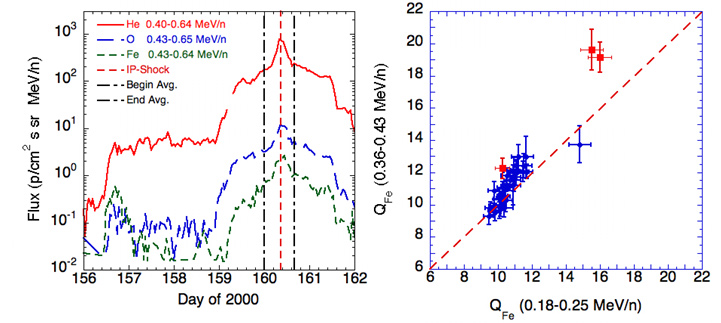
| ACE News Archives | ACE News #135 - October 21, 2010 |
Subscribe to ACE News |

Measurements obtained with advanced instrumentation onboard SAMPEX, SOHO and ACE over the last ~15 years show large variability in the mean ionic charge of heavy ions in solar energetic particle (SEP) events. This variability can be attributed to the contribution of different source populations to the particles observed in interplanetary space or to variable conditions during acceleration and propagation. Of particular importance is the energy range between ~0.1 and 0.5 MeV/amu covered by ACE/SEPICA, because here a systematic increase of the mean ionic charge with energy points to a source location low in the corona, where energy-dependent charge stripping effects become important, whereas a constant mean charge with energy implies acceleration in the high corona or in interplanetary space. ACE/SEPICA observations at energies <1 MeV/amu have demonstrated that ionic charge distributions and the energy dependence of the mean ionic charge, in particular for Fe, can be used to infer the contribution of different source populations (see ACE NEWS #99, #127) and to investigate plasma conditions in the acceleration region (see ACE News #107), respectively.
We have also used this powerful tool to investigate the source population of particles accelerated at interplanetary shocks. We determined the mean ionic charge of iron ions (QFe) in three energy bands between 0.18 - 0.43 MeV/amu for all interplanetary shock related events, where SEPICA data were available, during 1997 to 2000. A time period of several hours around the interplanetary shock passage was used to specifically exclude the onset phase of the events that are most likely dominated by particles accelerated close to the Sun. The left-hand panel shows, as an example, the SEP event on June 7, 2000, with an interplanetary shock on June 8 (day 160). Of particular importance is the energy dependence of the mean ionic charge of Fe ions. The right-hand panel shows the result of our analysis for the lowest (0.18-0.25 MeV/amu) and highest (0.36-0.43 MeV/amu) energy bands analyzed. A statistically significant increase of QFe between 0.18 and 0.43 MeV/amu is only observed in 3 of 35 cases (red filled squares). Two of these 3 events show high Fe abundances (Fe/O>1), and high charge states for Fe (~16) at 0.18 - 0.25 MeV/amu with a strong increase by 3 - 4 charge units between 0.18 and 0.43 MeV/amu, indicating an origin low in the corona, similar to the observation of many Fe-rich and 3He-rich events (see ACE News #107). The majority of the events (32 of 35), however, show ionic charge states of ~ 9 - 11 over the energy range in the study, independent of energy (blue crosses in the right-hand panel).
The average value of QFe for these 32 events is 10. 0.2, similar to Fe ionic charge states in the solar wind and at suprathermal energies of ~10-100 keV/amu. This result demonstrates that the source population in the majority of interplanetary shock related energetic ion events at energies < 1 MeV/amu is the solar wind or suprathermal particles of solar wind origin, rather than ions that originate in small, Fe-rich SEP events.
This item was contributed by Berndt Klecker, Max-Planck-Institut fur exterrestrische Physik, Garching, Germany, and Eberhard Moebius and Mark Popecki, University of New Hampshire. Address questions and comments to
Last modified 21 Oct 2010.